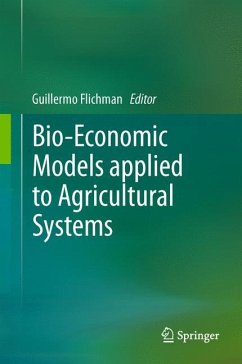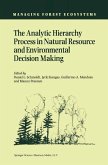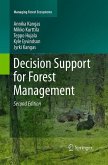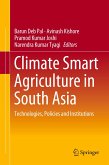This book has the purpose of providing the "state of the arts" concerning bio-economic modelling dealing with agricultural systems. In most cases, the contributions use a methodology combining the use of biophysical and economic models, in all cases, an engineering production function approach is totally or partially applied. This practice is being developed in the last years as a response to concrete policy matters: agricultural policies are increasingly combined with environmental and natural resources policies, and this reality involves the need of an integrated assessment, that current economic models are not able to provide.
The bio-economic modeling approach presented in this book is a result of two distinct developments: by one side, the improvement of bio-physical simulation models applied to agricultural systems and by the other, the evolution of agricultural policies demanding a kind of assessment that conventional economic models are not able to provide. Some economists began to realize that biophysical models could be considered as detailed engineering production functions, allowing to represent in a consistent manner the joint products of agricultural activities. The perspectives that this vision provides allow dealing with environmental and natural resources issues with an economic perspective in an efficient manner. Representing environmental impacts of agricultural activities measured in physical units allows performing cost-efficiency calculations of alternative policies, potentially able to attain specified policy targets. This capability permitted in recent years the development of applied research related with institutional demands from national and international public institutions. But this approach requires a multidisciplinary approach, with positive and negative effects. The positive one is, both for economists and biophysical scientists, to enlarge their vision of the world. The negative effects are the greater difficulty to get recognized in their specific discipline, the obstacles to obtain the necessary information for properly use these models, and the longer time to perform the research activity. The productivity for producing papers is lower for economists applying this approach compared with economists applying econometric methods, using available published data. In spite of these negative effects, as the demands from the real world for the assessment these models are able to provide is increasing, it is quite possible that there is a future for bio-economic models applied to agricultural systems. The challenges of Climate Change, the increase care for the preservation of natural resources and the environment will require further developments of this kind of approach. This book has the purpose of providing the "state of the arts" concerning bio-economic modelling dealing with agricultural systems. In most cases, the contributions use a methodology combining the use of biophysical and economic models, in all cases, an engineering production function approach is totally or partially applied. This practice is being developed in the last years as a response to concrete policy matters: agricultural policies are increasingly combined with environmental and natural resources policies, and this reality involves the need of an integrated assessment, that current economic models are not able to provide.
The bio-economic modeling approach presented in this book is a result of two distinct developments: by one side, the improvement of bio-physical simulation models applied to agricultural systems and by the other, the evolution of agricultural policies demanding a kind of assessment that conventional economic models are not able to provide. Some economists began to realize that biophysical models could be considered as detailed engineering production functions, allowing to represent in a consistent manner the joint products of agricultural activities. The perspectives that this vision provides allow dealing with environmental and natural resources issues with an economic perspective in an efficient manner. Representing environmental impacts of agricultural activities measured in physical units allows performing cost-efficiency calculations of alternative policies, potentially able to attain specified policy targets. This capability permitted in recent years the development of applied research related with institutional demands from national and international public institutions. But this approach requires a multidisciplinary approach, with positive and negative effects. The positive one is, both for economists and biophysical scientists, to enlarge their vision of the world. The negative effects are the greater difficulty to get recognized in their specific discipline, the obstacles to obtain the necessary information for properly use these models, and the longer time to perform the research activity. The productivity for producing papers is lower for economists applying this approach compared with economists applying econometric methods, using available published data. In spite of these negative effects, as the demands from the real world for the assessment these models are able to provide is increasing, it is quite possible that there is a future for bio-economic models applied to agricultural systems. The challenges of Climate Change, the increase care for the preservation of natural resources and the environment will require further developments of this kind of approach. This book has the purpose of providing the "state of the arts" concerning bio-economic modelling dealing with agricultural systems. In most cases, the contributions use a methodology combining the use of biophysical and economic models, in all cases, an engineering production function approach is totally or partially applied. This practice is being developed in the last years as a response to concrete policy matters: agricultural policies are increasingly combined with environmental and natural resources policies, and this reality involves the need of an integrated assessment, that current economic models are not able to provide.
From the reviews:
"This book is a collection of articles by European and American researchers on the use of bio-economic models applied to agricultural systems. The objective is ambitious: 'providing the state of the art' regarding bio-economic models. ... It will be indispensable for researchers in the field of mathematical programming applied to the agricultural sector." (Filippo Arfini, European Review of Agricultural Economics, Vol. 39 (5), December, 2012)
"This book is a collection of articles by European and American researchers on the use of bio-economic models applied to agricultural systems. The objective is ambitious: 'providing the state of the art' regarding bio-economic models. ... It will be indispensable for researchers in the field of mathematical programming applied to the agricultural sector." (Filippo Arfini, European Review of Agricultural Economics, Vol. 39 (5), December, 2012)








